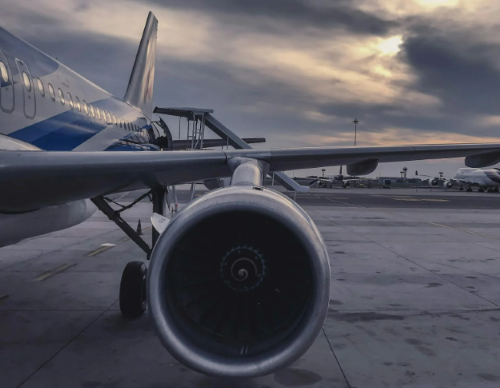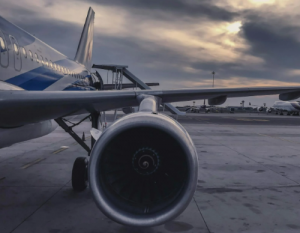List of Heat Resistance Materials for Jet Flights

List of Heat Resistance Materials
Heat-resistant materials are essential in various industries, especially aerospace. Metals and alloys like nickel-based superalloys and titanium are crucial for turbine engines and airframes. Ceramics such as silicon carbide and silicon nitride are used in automotive and aerospace parts for their durability and thermal shock resistance.

These advanced materials include nickel-based superalloys, titanium alloys, ceramics like silicon carbide and silicon nitride, carbon-carbon composites, and advanced polymers such as polyimides. Each of them is vital for applications in aerospace, automotive, energy, and electronics due to their high-temperature durability.
Related reading: A List Of Heat-Resistant Materials
Jet Flight Components High-temperature Requirements
Jet flight imposes unique challenges on aircraft components, primarily due to the high temperatures, oxidation risks, and thermal shock associated with high-speed travel and engine operation. The core requirements for these components, especially regarding heat resistance, include:
- High-Temperature Durability: Components must resist deformation and maintain structural integrity at temperatures often exceeding 1000°C, especially in engines.
- Thermal Shock Resistance: Materials should withstand rapid temperature changes without cracking, a critical property for parts exposed to sudden shifts during flight and landing.
- Oxidation and Corrosion Resistance: Exposure to high temperatures and reactive environments demands materials that can resist oxidative degradation and corrosion over time.
- Fatigue Resistance: Repeated thermal cycling and mechanical stresses require materials that can endure without failure to ensure long-term reliability and safety.
- Low Thermal Expansion: To maintain precise clearances between moving parts at different temperatures, materials with minimal thermal expansion are preferred.
- Weight Considerations: While heat resistance is crucial, materials must also support the overall design's weight efficiency to not compromise fuel efficiency and performance.
These challenges necessitate the continuous development of heat-resistant materials that can meet the rigorous demands of the aerospace industry, ensuring that aircraft and space vehicles can operate safely in the most demanding conditions.
List of Heat Resistance Materials for Jet Flights
For jet flights, materials must withstand high temperatures, pressure fluctuations, and oxidative environments. Here's a list of heat-resistant materials commonly used in jet flight applications, focusing on their utilization within jet engines and airframes:
--Metals and Alloys
- Nickel-based Superalloys: Used extensively in jet engine turbines and exhaust systems due to their excellent high-temperature strength and resistance to oxidation. Examples include Inconel, Hastelloy, and Nimonic.
- Titanium Alloys: Utilized in compressor blades, airframes, and engine components for their high strength-to-weight ratio and resistance to high temperatures and corrosion.
- Cobalt-based Alloys: Applied in turbine blades and vanes for their ability to maintain structural integrity at high temperatures.
- Stainless Steels: Employed in less critical, high-temperature parts of the engine and airframe for their good strength and corrosion resistance.
--Ceramics and Composites
- Ceramic Matrix Composites (CMCs): Used in turbine blades, vanes, and combustor liners. CMCs, such as silicon carbide matrix composites, withstand higher temperatures than metals, reducing the need for cooling air in engines.
- Silicon Carbide (SiC) and Silicon Nitride (Si3N4): Found in bearings and seals, these ceramics offer excellent thermal shock resistance and durability at high temperatures.
--Carbon-based Materials
- Carbon-Carbon Composites: Used in brake systems and nozzle components, offering unmatched heat resistance and structural strength at the temperatures encountered during high-speed flight and braking.
--Coatings
- Thermal Barrier Coatings (TBCs): Yttria-stabilized zirconia (YSZ) coatings are applied to turbine blades and other components to insulate them from the hot gases in combustion chambers, significantly increasing component life.
- Aluminide Coatings: Protect turbine blades and other engine parts from oxidation and corrosion at high temperatures.
--Polymers
- Polyimides: These polymers are used in thermal insulation, seals, and composite matrix materials for their ability to withstand high temperatures and chemical degradation.
--Special Materials
- Refractory Metals: Such as tungsten, molybdenum, and their alloys are used in specific high-temperature applications like electrical contacts in engines and heat shields.
- Aerogels: Employed for thermal insulation in specific high-altitude, high-speed aircraft applications due to their low thermal conductivity and low density.
Heat Resistance Material Suppliers
Each of these materials (See Table 1) is chosen based on the specific requirements of the jet flight components they are used in, balancing factors like temperature resistance, strength, weight, and cost. The ongoing development of new materials and composites continues to push the boundaries of jet flight, enabling engines to run hotter and more efficiently while improving overall aircraft performance and fuel efficiency.
Table 1. List of Heat Resistance Materials for Jet Flights
| Material | Application | Characteristics |
| Nickel-based Superalloys | Jet engine turbines, exhaust systems | High-temperature strength, oxidation resistance |
| Titanium Alloys | Compressor blades, airframes, engine components | High strength-to-weight ratio, high-temperature, and corrosion resistance |
| Cobalt-based Alloys | Turbine blades, vanes | Maintains structural integrity at high temperatures |
| Stainless Steels | High-temperature parts of the engine and airframe | Good strength and corrosion resistance |
| Ceramic Matrix Composites (CMCs) | Turbine blades, vanes, combustor liners | Withstands higher temperatures than metals, reduces cooling air |
| Silicon Carbide (SiC) & Silicon Nitride (Si3N4) | Bearings, seals | Excellent thermal shock resistance, durability at high temperatures |
| Carbon-Carbon Composites | Brake systems, nozzle components | Unmatched heat resistance and structural strength at high temperatures |
| Thermal Barrier Coatings (TBCs) | Insulation for turbine blades, combustion chamber components | Insulates from hot gases, increases component life |
| Aluminide Coatings | Oxidation and corrosion protection for engine parts | Protection from oxidation and corrosion at high temperatures |
| Polyimides | Thermal insulation, seals, composite matrix materials | Withstands high temperatures and chemical degradation |
| Refractory Metals | Electrical contacts in engines, heat shields | Used in specific high-temperature applications |
| Aerogels | Thermal insulation in specific high-altitude, high-speed aircraft | Low thermal conductivity and low density |
Advanced Refractory Metals (ARM), headquartered in Lake Forest, California, stands out as a premier manufacturer and supplier of refractory metals since 1994. ARM's product lineup is impressive, including Tungsten, Molybdenum, Tantalum, Rhenium, Titanium, and Zirconium.
ARM is committed to providing high-quality products globally, tailoring its services to meet the specific needs of its customers. ARM's broad product range also includes superalloys, advanced ceramics, and other high-temperature materials. Their expertise isn't limited to manufacturing. For more detailed information about Advanced Refractory Metals and their offerings, please check the homepage.
{{item.content}}
LEVE A REPLY
{{item.children[0].content}}
{{item.content}}






